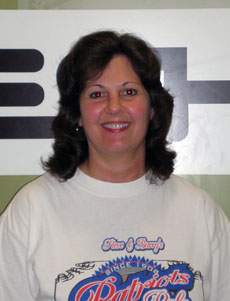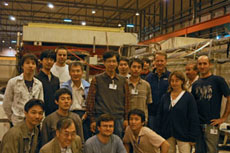|
Wed., July 18
THERE WILL BE NO FERMILAB ILC R&D MEETING THIS WEEK
3:30 p.m.
DIRECTOR'S COFFEE BREAK - 2nd Flr X-Over
THERE WILL BE NO FERMILAB COLLOQUIUM THIS WEEK
Thurs., July 19
10:30 a.m.
Research Techniques Seminar - WH-10NW, West Wing
Speaker: T. Pierzchala, Université Catholique de Louvain
Title: GASTOF: A Fast Time-of-Flight Counter for LHC Experiments
1:00 p.m.
ILC ALCPG Physics and Detector R&D Seminar - WH-10NW, West Wing
Speaker: T. Rizzo, Stanford Linear Accelerator Center
Title: LHC-1 = ILC Project Update (take two)
2:30 p.m.
Theoretical Physics Seminar - Curia II
Speaker: J.-W. Qiu, Iowa State University
Title: QCD Factorization for Heavy Quarkonium Production at Collider Energies
3:30 p.m.
DIRECTOR'S COFFEE BREAK - 2nd Flr X-Over
4:00 p.m.
Special Joint Experimental-Theoretical Physics Seminar - One West (NOTE DATE)
Speaker: N. Saoulidou, Fermilab
Title: Updated Results on nm Disappearance from MINOS
THERE WILL BE NO ACCELERATOR PHYSICS AND TECHNOLOGY SEMINAR TODAY
Click here for NALCAL,
a weekly calendar with links to additional information.
|
Wednesday, July 18
-Vegetable Beef
-Fish & chips
-Smart Cuisine: grilled salmon
-Country fried steak w/pepper gravy
-Beef & cheddar panini w/sauteed onions
-Assorted sliced pizza
-Cavatappi pasta w/Italian sausage & tomato ragu
Wilson Hall Cafe Menu |
|
Wednesday, July 18
Lunch
- Shrimp & barley salad w/green beans
- Summer melons in spiced white wine
Thursday, July 19
Dinner
- Grilled portobello and red pepper salad
- Scampi
- Vegetable of the season
- Chocolate strawberry shortcake
Chez Leon Menu
Call x4598 to make your reservation. |
|
|
ES&H's Kathy Graden helps make Fermilab a safe place
 |
| Kathy Graden |
Chances are that regardless of the job you do at Fermilab, you've encountered some of Kathy Graden's work. DZero's calorimeter can't run unless she tracks and controls its depleted uranium supply, and employees aren't authorized to work unless they complete the online training course she helped develop.
As Radioactive Source Program Manager, Graden ensures that all radioactive sources at the lab are properly controlled. She writes DOE accountability reports, issues radioactive sources for various experiments and regulates the use of all nuclear materials at Fermilab.
"There are hundreds of radioactive sources installed in detectors and also on radiation survey instruments," said Graden. "It is my job to make sure that they are all properly used and accounted for."
Graden's eighteen year history at the lab has earned her equal amounts of respect and responsibility in roles involving radiation protection, inventory and education. The Radiation Physics team - and certainly the rest of Fermilab - depends on her to keep things safe and organized.
"Radiation safety has always played an important role at Fermilab," said Graden. "My work fits into Fermilab's mission by ensuring that employees and researchers conduct their work and research with radioactive sources and nuclear materials in a safe manner."
-- Lauren Younis
|
From Science Daily,
July 17, 2007
New fundamental particle is discovered
CHAMPAIGN, Ill., July 17 (UPI) -- U.S. physicists at the University of Illinois have found a new fundamental particle -- a boson with a charge of 2e, but not consisting of two electrons.
Physics Professor Philip Phillips said the new boson is not formed from electrons and ions. Instead, it emerges as a remnant of strong interactions between electrons in the normal state.
"High- and low-energy scales are inextricably coupled in the cuprates (copper-oxide ceramics)," said Phillips. "Normally, when you remove a single electron from most systems, one empty state is created. In the cuprates, however, when you remove an electron, you create two empty states -- both of which occur at low energy, but paradoxically, one of the states comes from the high-energy scale."
Read more
|
From Interactions.org,
July 17, 2007
Gruber Cosmology Prize Awarded to Discoverers of Dark Energy
BERKELEY, CA -- The 2007 Gruber Cosmology Prize has been awarded jointly to Saul Perlmutter of the Department of Energy's Lawrence Berkeley National Laboratory and the University of California at Berkeley, Brian Schmidt of the Australian National University, and members of the two international teams that these researchers led in discovering the accelerating expansion of the universe -- the Supernova Cosmology Project and the High-Z Supernova Search Team.
"The Gruber Cosmology Prize is a great honor for all of us in both teams," says Perlmutter. "It's rare that a scientific prize is able to include a very large number of those in the community whose work actually became the underpinnings of the discovery being celebrated. Yet with the exception of a few notable contributors, that's the case here -- and that's terrific."
Read more
|
|
|
Experiment in synergy:
LHCf and cosmic rays

Members of the LHCf collaboration
The LHCf collaboration may only have 25 members, but its work could have a big impact on cosmic-ray research. LHCf scientists will study LHC proton-proton collisions similar to the collisions of ultra high-energy cosmic rays with the earth's atmosphere. Their results will contribute to the measurement of the energy of these cosmic rays by the large cosmic ray experiments at the Pierre Auger Observatory in Argentina and the Telescope Array in Utah.
Cosmic rays are charged particles - mainly protons - that travel through space. Most of these particles are well understood, but a tiny number with ultra high energies (1018 eV to above 1020 eV) remain a mystery. Ultra high-energy cosmic rays with energies above 1020 eV are rare - only about one per square kilometer per century hits the earth. Experiments like the Pierre Auger Observatory and Telescope Array are hoping to resolve the mysteries of how and where these ultra high-energy cosmic rays are produced. Meanwhile, scientists, like William Turner, U.S. LHCf collaborator based at the Lawrence Berkeley National Laboratory, are planning to contribute to this effort. At LHCf, they will make key measurements that the Pierre Auger Observatory and Telescope Array will use to simulate and interpret the air showers - cascades of secondary particles - produced by ultra high-energy cosmic rays.
"Scientists are interested in ultra high-energy cosmic rays because they are a mystery," Turner said. "We don't know if they can be understood in terms of our existing knowledge of physics or if solving the mystery will require new physics."
When cosmic rays enter the earth's atmosphere, the charged particles collide with nuclei in the upper atmosphere and produce secondary particles, including neutral pions, which in turn generate air showers. These shower particles travel forward from the original collision in approximately the same direction as the original ray. Similarly, many of the proton-proton collisions at the LHC produce neutral pions in the same forward direction as the proton beam. The LHCf detectors will be placed on either side of the ATLAS experiment about 140 meters from the interaction point at a zero degree collision angle. The detectors, made of tungsten plates and plastic scintillators, can accurately measure the number and energy of neutral pions produced in the forward direction in ATLAS collisions.
The LHCf experiment will explore cosmic-ray-like collisions equivalent to a cosmic ray of 1017 eV striking the atmosphere, nearly 1,000 times more energy than in previous experiments.
-- Amelia Williamson |
|
2007 GSA Triathlon
The 2007 GSA Triathlon will take place on August 11, 2007. Those interested in participating should email Mandy Rominsky as soon as possible. Please include your estimated swim time and overall completion time in your message. Volunteers are also needed to help during the event and should contact Mandy.
Lifeguards needed
The Recreation Office is looking for lifeguards to work part-time or full-time, days, evenings through Labor Day weekend. Please direct interested candidates to the Fermilab Employment page to fill out an application.
Salary Review Process Information
General information for all employees on updates to the salary review process is now available online. Please review this presentation. If you have any questions on the information provided or any topic related to the upcoming salary review, please attend one of the town-hall meetings scheduled for 1:30 p.m. on July 25, 26, and 31 in Wilson Hall, One West.
Additional Activities
|
|